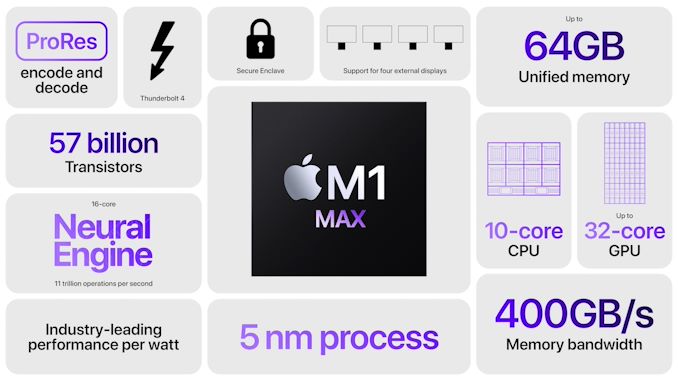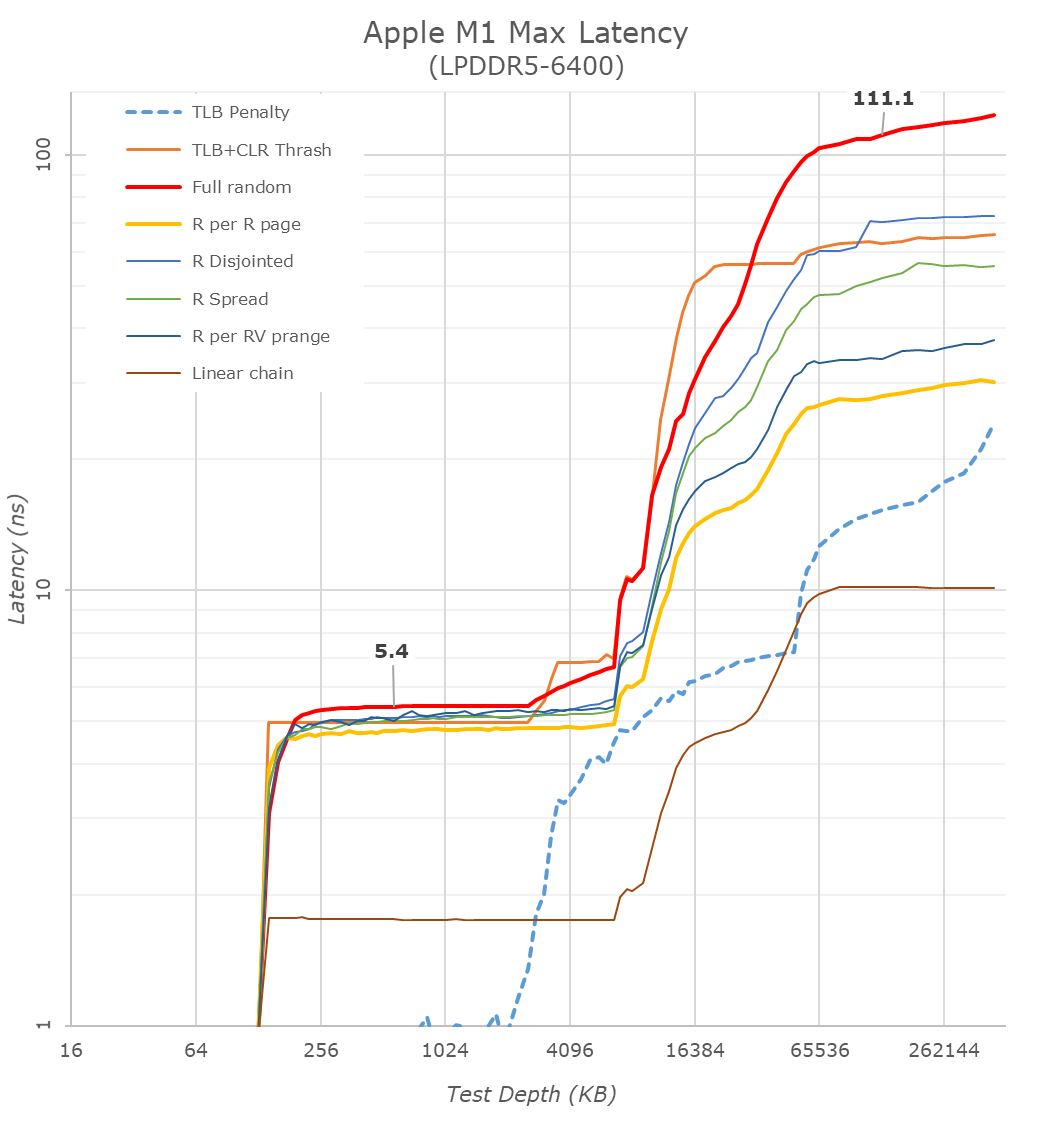Apple's M1 Pro, M1 Max SoCs Investigated: New Performance and Efficiency Heights
by Andrei Frumusanu on October 25, 2021 9:00 AM EST- Posted in
- Laptops
- Apple
- MacBook
- Apple M1 Pro
- Apple M1 Max
Huge Memory Bandwidth, but not for every Block
One highly intriguing aspect of the M1 Max, maybe less so for the M1 Pro, is the massive memory bandwidth that is available for the SoC.
Apple was keen to market their 400GB/s figure during the launch, but this number is so wild and out there that there’s just a lot of questions left open as to how the chip is able to take advantage of this kind of bandwidth, so it’s one of the first things to investigate.
Starting off with our memory latency tests, the new M1 Max changes system memory behaviour quite significantly compared to what we’ve seen on the M1. On the core and L2 side of things, there haven’t been any changes and we consequently don’t see much alterations in terms of the results – it’s still a 3.2GHz peak core with 128KB of L1D at 3 cycles load-load latencies, and a 12MB L2 cache.
Where things are quite different is when we enter the system cache, instead of 8MB, on the M1 Max it’s now 48MB large, and also a lot more noticeable in the latency graph. While being much larger, it’s also evidently slower than the M1 SLC – the exact figures here depend on access pattern, but even the linear chain access shows that data has to travel a longer distance than the M1 and corresponding A-chips.
DRAM latency, even though on paper is faster for the M1 Max in terms of frequency on bandwidth, goes up this generation. At a 128MB comparable test depth, the new chip is roughly 15ns slower. The larger SLCs, more complex chip fabric, as well as possible worse timings on the part of the new LPDDR5 memory all could add to the regression we’re seeing here. In practical terms, because the SLC is so much bigger this generation, workloads latencies should still be lower for the M1 Max due to the higher cache hit rates, so performance shouldn’t regress.
A lot of people in the HPC audience were extremely intrigued to see a chip with such massive bandwidth – not because they care about GPU or other offload engines of the SoC, but because the possibility of the CPUs being able to have access to such immense bandwidth, something that otherwise is only possible to achieve on larger server-class CPUs that cost a multitude of what the new MacBook Pros are sold at. It was also one of the first things I tested out – to see exactly just how much bandwidth the CPU cores have access to.
Unfortunately, the news here isn’t the best case-scenario that we hoped for, as the M1 Max isn’t able to fully saturate the SoC bandwidth from just the CPU side;
From a single core perspective, meaning from a single software thread, things are quite impressive for the chip, as it’s able to stress the memory fabric to up to 102GB/s. This is extremely impressive and outperforms any other design in the industry by multiple factors, we had already noted that the M1 chip was able to fully saturate its memory bandwidth with a single core and that the bottleneck had been on the DRAM itself. On the M1 Max, it seems that we’re hitting the limit of what a core can do – or more precisely, a limit to what the CPU cluster can do.
The little hump between 12MB and 64MB should be the SLC of 48MB in size, the reduction in BW at the 12MB figure signals that the core is somehow limited in bandwidth when evicting cache lines back to the upper memory system. Our test here consists of reading, modifying, and writing back cache lines, with a 1:1 R/W ratio.
Going from 1 core/threads to 2, what the system is actually doing is spreading the workload across the two performance clusters of the SoC, so both threads are on their own cluster and have full access to the 12MB of L2. The “hump” after 12MB reduces in size, ending earlier now at +24MB, which makes sense as the 48MB SLC is now shared amongst two cores. Bandwidth here increases to 186GB/s.
Adding a third thread there’s a bit of an imbalance across the clusters, DRAM bandwidth goes to 204GB/s, but a fourth thread lands us at 224GB/s and this appears to be the limit on the SoC fabric that the CPUs are able to achieve, as adding additional cores and threads beyond this point does not increase the bandwidth to DRAM at all. It’s only when the E-cores, which are in their own cluster, are added in, when the bandwidth is able to jump up again, to a maximum of 243GB/s.
While 243GB/s is massive, and overshadows any other design in the industry, it’s still quite far from the 409GB/s the chip is capable of. More importantly for the M1 Max, it’s only slightly higher than the 204GB/s limit of the M1 Pro, so from a CPU-only workload perspective, it doesn’t appear to make sense to get the Max if one is focused just on CPU bandwidth.
That begs the question, why does the M1 Max have such massive bandwidth? The GPU naturally comes to mind, however in my testing, I’ve had extreme trouble to find workloads that would stress the GPU sufficiently to take advantage of the available bandwidth. Granted, this is also an issue of lacking workloads, but for actual 3D rendering and benchmarks, I haven’t seen the GPU use more than 90GB/s (measured via system performance counters). While I’m sure there’s some productivity workload out there where the GPU is able to stretch its legs, we haven’t been able to identify them yet.
That leaves everything else which is on the SoC, media engine, NPU, and just workloads that would simply stress all parts of the chip at the same time. The new media engine on the M1 Pro and Max are now able to decode and encode ProRes RAW formats, the above clip is a 5K 12bit sample with a bitrate of 1.59Gbps, and the M1 Max is not only able to play it back in real-time, it’s able to do it at multiple times the speed, with seamless immediate seeking. Doing the same thing on my 5900X machine results in single-digit frames. The SoC DRAM bandwidth while seeking around was at around 40-50GB/s – I imagine that workloads that stress CPU, GPU, media engines all at the same time would be able to take advantage of the full system memory bandwidth, and allow the M1 Max to stretch its legs and differentiate itself more from the M1 Pro and other systems.













493 Comments
View All Comments
unclevagz - Monday, October 25, 2021 - link
Is the M1 Max here being tested on the so called "high power" mode?Andrei Frumusanu - Monday, October 25, 2021 - link
No.unclevagz - Monday, October 25, 2021 - link
Is the high power mode a selectable option on your review unit?Ryan Smith - Monday, October 25, 2021 - link
It's selectable on the 16-inch models. However it's not needed for anything short of the heaviest combined CPU + GPU workloads. Any pure CPU or GPU workload doesn't come close to the thermal limits of the machine. And even a moderate mixed workload like Premiere Pro didn't benefit from High Power mode.It has a reason to exist, but that reason is close to rendering a video overnight - as in a very hard and very sustained total system workload.
unclevagz - Monday, October 25, 2021 - link
So from your comment, I take it that the high power mode doesn't do anything to performance except allow the fans to kick in more aggressively rather than clock down the CPU/GPU in thermally limited scenarios?hmw - Monday, October 25, 2021 - link
Ryan, Andrei - so would the high power mode be something that prevents throttling or frequency downshifting when running sustained CPU + GPU workloads that might otherwise cause the machine to throttle or run over the combined limit (example > 120W ) ? If so, makes sense - it's just adjusting the power profile much like in Windows ...Just trying to decide between the lighter 14" and the heavier 16", seems like both models score equally well on the benchmarks otherwise ...
Ryan Smith - Tuesday, October 26, 2021 - link
" so would the high power mode be something that prevents throttling or frequency downshifting when running sustained CPU + GPU workloads that might otherwise cause the machine to throttle or run over the combined limit (example > 120W ) ? "Correct.
But being aware of the throttling issues on the Touch Bar 15/16 Inch MBPs, I should emphasize that we're not seeing throttling to begin with. Even "typical" heavy workloads like games aren't having problems. HP mode exists because there are edge cases, but unlike past MBPs, it seems you have to really work at it to find them.
BillBear - Monday, October 25, 2021 - link
I would expect "high power" mode to just be "crank the fans up and leave them up" mode.For instance, that MSI GE76 Raider with a GTX 3080 has such a mode:
>The downside of the extreme performance mode though is noise, with the system peaking around 55 dB(A) measured one inch over the trackpad. If you are going to run at maximum, you would really need closed-back earphones to try and remove some of the noise.
https://www.anandtech.com/show/16928/the-msi-ge76-...
Tyrone91 - Monday, October 25, 2021 - link
No Cinebench R23? Those R23 MT scores seem much closer to the Intel/AMD laptop chips.sirmo - Monday, October 25, 2021 - link
The only useful test I wanted to see. What's weird is it's present in the power consumption chart. So why not post the results?